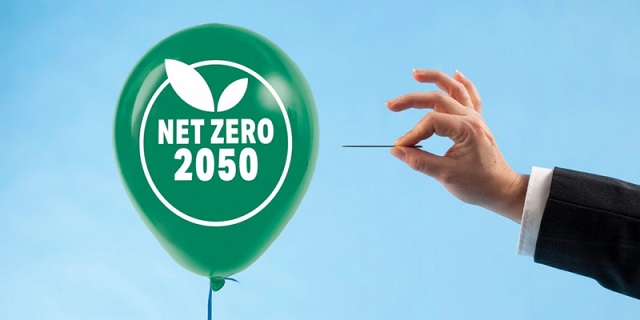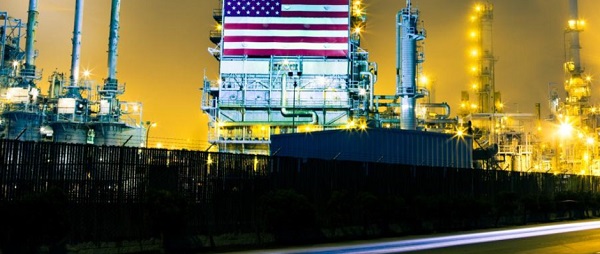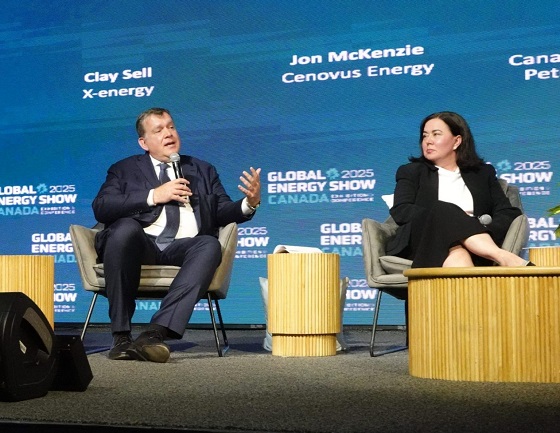Energy
Halfway Between Kyoto and 2050: Zero Carbon Is a Highly Unlikely Outcome

From the Fraser Institute
By Vaclav Smil
The global goal to achieve “net-zero” carbon emissions by 2050 is impractical and unrealistic, finds a new study published today by the Fraser Institute, an independent, non-partisan Canadian public policy think-tank.
“The plan to eliminate fossil fuels and achieve a net-zero economy faces formidable economic, political and practical challenges,” said Vaclav Smil, professor emeritus at the University of Manitoba and author of Halfway Between Kyoto and 2050: Zero Carbon Is a Highly Unlikely Outcome.
Canada is now also committed to this goal. In 2021, the federal government passed legislation mandating that the country will achieve “net-zero” emissions—that is, will either emit no greenhouse gas emissions or offset its emissions through other activities (e.g. tree planting)—by 2050.
Yet, despite international agreements and significant spending and regulations by governments worldwide, global dependence on fossil fuels has steadily increased over the past three decades. By 2023, global fossil fuel consumption was 55 per cent higher than in 1997 (when the Kyoto Protocol was adopted). And the share of fossil fuels in global energy consumption has only slightly decreased, dropping from 86 per cent in 1997 to 82 per cent in 2022 (the latest year of complete production data).
Widespread adoption of electric vehicles—also a key component of Ottawa’s net-zero plan—by 2040 will require more than 40 times more lithium and up to 25 times more cobalt, nickel and graphite worldwide (compared to 2020 levels). There are serious questions about the ability to achieve such increases in mineral and metal production.
Although the eventual cost of global decarbonization cannot be reliably quantified, achieving zero carbon by 2050 would require spending substantially higher than for any previous long-term peacetime commitments. Moreover, high-income countries (including Canada) are also expected to finance new energy infrastructure in low-income economies, further raising their decarbonization burdens.
Finally, achieving net-zero requires extensive and sustained global cooperation among countries—including China and India—that have varied levels of commitment to decarbonization.
“Policymakers must face reality—while ending our reliance on fossil fuels may be a desirable long-term goal, it cannot be accomplished quickly or inexpensively,” said Elmira Aliakbari, director of natural resource studies at the Fraser Institute.

Summary
- This essay evaluates past carbon emission reduction and the feasibility of eliminating fossil fuels to achieve net-zero carbon by 2050.
- Despite international agreements, government spending and regulations, and technological advancements, global fossil fuel consumption surged by 55 percent between 1997 and 2023. And the share of fossil fuels in global energy consumption has only decreased from nearly 86 percent in 1997 to approximately 82 percent in 2022.
- The first global energy transition, from traditional biomass fuels such as wood and charcoal to fossil fuels, started more than two centuries ago and unfolded gradually. That transition remains incomplete, as billions of people still rely on traditional biomass energies for cooking and heating.
- The scale of today’s energy transition requires approximately 700 exajoules of new non-carbon energies by 2050, which needs about 38,000 projects the size of BC’s Site C or 39,000 equivalents of Muskrat Falls.
- Converting energy-intensive processes (e.g., iron smelting, cement, and plastics) to non-fossil alternatives requires solutions not yet available for largescale use.
- The energy transition imposes unprecedented demands for minerals including copper and lithium, which require substantial time to locate and develop mines.
- To achieve net-zero carbon, affluent countries will incur costs of at least 20 percent of their annual GDP.
- While global cooperation is essential to achieve decarbonization by 2050, major emitters such as the United States, China, and Russia have conflicting interests.
- To eliminate carbon emissions by 2050, governments face unprecedented technical, economic and political challenges, making rapid and inexpensive transition impossible.
Author:
Alberta
Calls for a new pipeline to the coast are only getting louder

From Resource Works
Alberta wants a new oil pipeline to Prince Rupert in British Columbia.
Calls on the federal government to fast-track new pipelines in Canada have grown. But there’s some confusion that needs to be cleared up about what Ottawa’s intentions are for any new oil and gas pipelines.
Prime Minister Carney appeared to open the door for them when he said, on June 2, that he sees opportunity for Canada to build a new pipeline to ship more oil to foreign markets, if it’s tied to billions of dollars in green investments to reduce the industry’s environmental footprint.
But then he confused that picture by declaring, on June 6, that new pipelines will be built only with “a consensus of all the provinces and the Indigenous people.” And he added: “If a province doesn’t want it, it’s impossible.”
And BC Premier David Eby made it clear on June 2 that BC doesn’t want a new oil pipeline, nor does it want Ottawa to cancel the related ban on oil tankers steaming through northwest BC waters. These also face opposition from some, but not all, First Nations in BC.
Eby’s energy minister, Adrian Dix, also gave thumbs-down to a new oil pipeline, but did say BC supports expanding the capacity of the existing Trans Mountain TMX oil pipeline, and the dredging of Burrard Inlet to allow bigger oil tankers to load Alberta oil from TMX at the port of Vancouver.
While the feds sort out what their position is on fast-tracking new pipelines, Alberta Premier Danielle Smith leaped on Carney’s talk of a new oil pipeline if it’s tied to lowering the carbon impact of the Alberta oilsands and their oil.
She saw “a grand bargain,” with, in her eyes, a new oil pipeline from Alberta to Prince Rupert, BC, producing $20 billion a year in revenue, some of which could then be used to develop and install carbon-capture mechanisms for the oil.
She noted that the Pathways Alliance, six of Canada’s largest oilsands producers, proposed in 2021 a carbon-capture network and pipeline that would transport captured CO₂ from some 20 oilsands facilities, by a new 400-km pipeline, to a hub in the Cold Lake area of Alberta for permanent underground storage.
Preliminary estimates of the cost of that project run up to $20 billion.
The calls for a new oil pipeline from Bruderheim, AB, to Prince Rupert recall the old Northern Gateway pipeline project that was proposed to run from Alberta to Kitimat, BC.
That was first proposed by Enbridge in 2008, and there were estimates that it would mean billions in government revenues and thousands of jobs.
In 2014, Conservative prime minister Stephen Harper approved Northern Gateway. But in 2015, the Federal Court of Appeal overruled the Harper government, ruling that it had “breached the honour of the Crown by failing to consult” with eight affected First Nations.
Then the Liberal government of Prime Minister Justin Trudeau, who succeeded Harper in 2015, effectively killed the project by instituting a ban on oil tanker traffic on BC’s north coast shortly after taking office.
Now Danielle Smith is working to present Carney with a proponent and route for a potential new crude pipeline from Alberta to Prince Rupert.
She said her government is in talks with Canada’s major pipeline companies in the hope that a private-sector proponent will take the lead on a pipeline to move a million barrels a day of crude to the BC coast.
She said she hopes Carney, who won a minority government in April, will make good on his pledge to speed permitting times for major infrastructure projects. Companies will not commit to building a pipeline, Smith said, without confidence in the federal government’s intent to bring about regulatory reform.
Smith also underlined her support for suggested new pipelines north to Grays Bay in Nunavut, east to Churchill, Manitoba, and potentially a new version of Energy East, a proposed, but shelved, oil pipeline to move oil from Alberta and Saskatchewan to refineries and a marine terminal in the Maritimes.
The Energy East oil pipeline was proposed in 2013 by TC Energy, to move Western Canadian crude to an export terminal at St. John, NB, and to refineries in eastern Canada. It was mothballed in 2017 over regulatory hurdles and political opposition in Quebec.
A separate proposal known as GNL Quebec to build a liquefied natural gas pipeline and export terminal in the Saguenay region was rejected by both federal and provincial authorities on environmental grounds. It would have diverted 19.4 per cent of Canadian gas exports to Europe, instead of going to the US.
Now Quebec’s environment minister Benoit Charette says his government would be prepared to take another look at both projects.
The Grays Bay idea is to include an oil pipeline in a corridor that would run from northern BC to Grays Bay in Nunavut. Prime Minister Carney has suggested there could be opportunities for such a pipeline that would carry “decarbonized” oil to new markets.
There have also been several proposals that Canada should build an oil pipeline, and/or a natural gas pipeline, to the port of Churchill. One is from a group of seven senior oil and gas executives who in 2017 suggested the Western Energy Corridor to Churchill.
Now a group of First Nations has proposed a terminal at Port Nelson, on Hudson Bay near Churchill, to ship LNG to Europe and potash to Brazil. And the Manitoba government is looking at the idea.
“There is absolutely a business case for sending our LNG directly to European markets rather than sending our natural gas down to the Gulf Coast and having them liquefy it and ship it over,” says Robyn Lore of project backer NeeStaNan. “It’s in Canada’s interest to do this.”
And, he adds: “The port and corridor will be 100 per cent Indigenous owned.”
Manitoba Premier Wab Kinew has suggested that the potential trade corridor to Hudson Bay could handle oil, LNG, hydrogen, and potash slurry. (One obvious drawback, though, winter ice limits the Hudson Bay shipping season to four months of the year, July to October.)
All this talk of new pipelines comes as Canada begins to look for new markets to reduce reliance on the US, following tariff measures from President Donald Trump.
Alberta Premier Smith says: “I think the world has changed dramatically since Donald Trump got elected in November. I think that’s changed the national conversation.”
And she says that if Carney wants a true nation-building project to fast-track, she can’t think of a better one than a new West Coast oil pipeline.
“I can’t imagine that there will be another project on the national list that will generate as much revenue, as much GDP, as many high paying jobs as a bitumen pipeline to the coast.”
Now we need to know what Mark Carney’s stance on pipelines really is: Is it fast-tracking them to reduce our reliance on the US? Or is it insisting that, for a pipeline, “If a province doesn’t want it, it’s impossible.”
Daily Caller
‘Not Held Hostage Anymore’: Economist Explains How America Benefits If Trump Gets Oil And Gas Expansion


From the Daily Caller News Foundation
Economist Steve Moore appeared on Fox Business Tuesday to discuss what he called the significance of expanding domestic oil and gas production in the United States.
President Donald Trump’s Executive Order 14154 aims to secure U.S. energy independence and global leadership by awarding 10-year oil and gas leases. During an appearance on “The Bottom Line,” Moore said that if Trump’s energy policies succeed then America will no longer have to rely on foreign oil.
“If Trump goes forward with what he wants to do, and our energy secretary is all in on this, produce as much oil and gas as we can here at home in Texas and North Dakota and Oklahoma and these other states. Then we’re not held hostage anymore to what’s happening in the Middle East,” Moore said. “That’s what’s so frustrating. We have more of this stuff than anybody does.”
WATCH:
Moore then pointed to some of former President Joe Biden’s early decisions, particularly the cancellation of pipelines. Moore said these actions left the U.S. vulnerable to external energy crises.
“I don’t want to overemphasize the Strategic Petroleum Reserve. It’s good that we have this sort of safety knot in case you have some kind of blow up in the Middle East, like we have now. But, ultimately, what Joe Biden did was the most sinister of all,” Moore said. “You guys remember what was the first thing when he became president? He canceled pipelines. He destroyed our energy infrastructure.”
During his first term, Trump signed executive orders to advance major pipelines, including instructing TransCanada to resubmit its application for a cross-border permit for the Keystone XL Pipeline, which is designed to transport oil from the tar sands of Alberta, Canada to refineries on the Gulf Coast. On his first day in office, Biden revoked the permit for the Keystone XL Pipeline, effectively halting its development.
-

 Health2 days ago
Health2 days agoLast day and last chance to win this dream home! Support the 2025 Red Deer Hospital Lottery before midnight!
-

 Aristotle Foundation2 days ago
Aristotle Foundation2 days agoThe Canadian Medical Association’s inexplicable stance on pediatric gender medicine
-

 Energy2 days ago
Energy2 days agoCould the G7 Summit in Alberta be a historic moment for Canadian energy?
-

 Crime2 days ago
Crime2 days agoMinnesota shooter arrested after 48-hour manhunt
-

 Bruce Dowbiggin2 days ago
Bruce Dowbiggin2 days agoWOKE NBA Stars Seems Natural For CDN Advertisers. Why Won’t They Bite?
-

 Business2 days ago
Business2 days agoCarney’s Honeymoon Phase Enters a ‘Make-or-Break’ Week
-

 conflict1 day ago
conflict1 day agoTrump leaves G7 early after urging evacuation of Tehran
-

 Alberta2 days ago
Alberta2 days agoAlberta announces citizens will have to pay for their COVID shots






